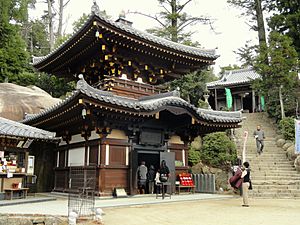Daidō facts for kids
Daidō (大同) was a special time period in Japanese history, like an era name (called nengō). It came after the Enryaku era and before the Kōnin era. This era lasted from May 806 to September 810. During the Daidō era, two emperors ruled Japan: Heizei-tennō (平城天皇) and Saga-tennō (嵯峨天皇).
Important Events of the Daidō Era

In Daidō 1, the Buddhist monk Kūkai settled in a spiritual retreat at Miyajima.
- 806 (Daidō 1): A famous Buddhist monk named Kūkai (空海) (also known as Kōbō-Daishi (弘法大師)) returned to Japan. He had been studying in China. Kūkai settled in a place called Miyajima and started a temple there called Daishō-in (大聖院).
- April 9, 806 (Daidō 1, 17th day of the 3rd month): Emperor Kammu passed away. He had ruled for 25 years. His son then took over as the new emperor. This process is called a senso. Soon after, his son, Emperor Heizei, officially accepted his role and duties. This was confirmed in special ceremonies.
- May 18, 809 (Daidō 4, 1st day of the 4th month): Emperor Heizei decided to step down from his role. This is called abdicating. He had ruled for four years. His second son then became the new ruler, known as Emperor Saga.
Related Information
- Heian period: Learn more about the long period in Japanese history that included the Daidō era.
- National Diet Library: You can find more historical information about the Japanese calendar and eras on their website.
| Daidō | 1st | 2nd | 3rd | 4th |
|---|---|---|---|---|
| 806 | 807 | 808 | 809 |
| Preceded by: Enryaku |
Era or nengō: Daidō |
Succeeded by: Kōnin |
See also
 In Spanish: Daidō para niños
In Spanish: Daidō para niños

All content from Kiddle encyclopedia articles (including the article images and facts) can be freely used under Attribution-ShareAlike license, unless stated otherwise. Cite this article:
Daidō Facts for Kids. Kiddle Encyclopedia.
